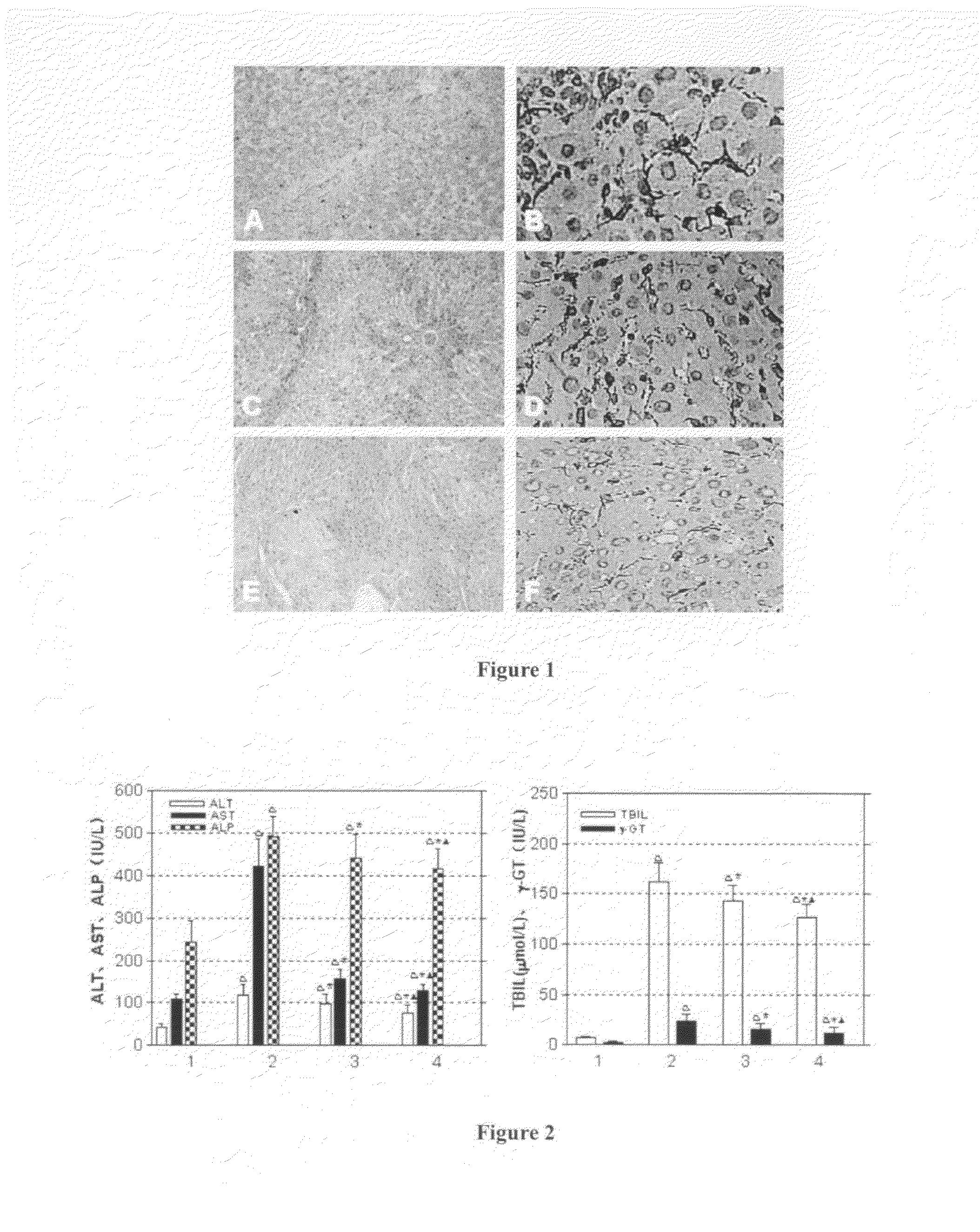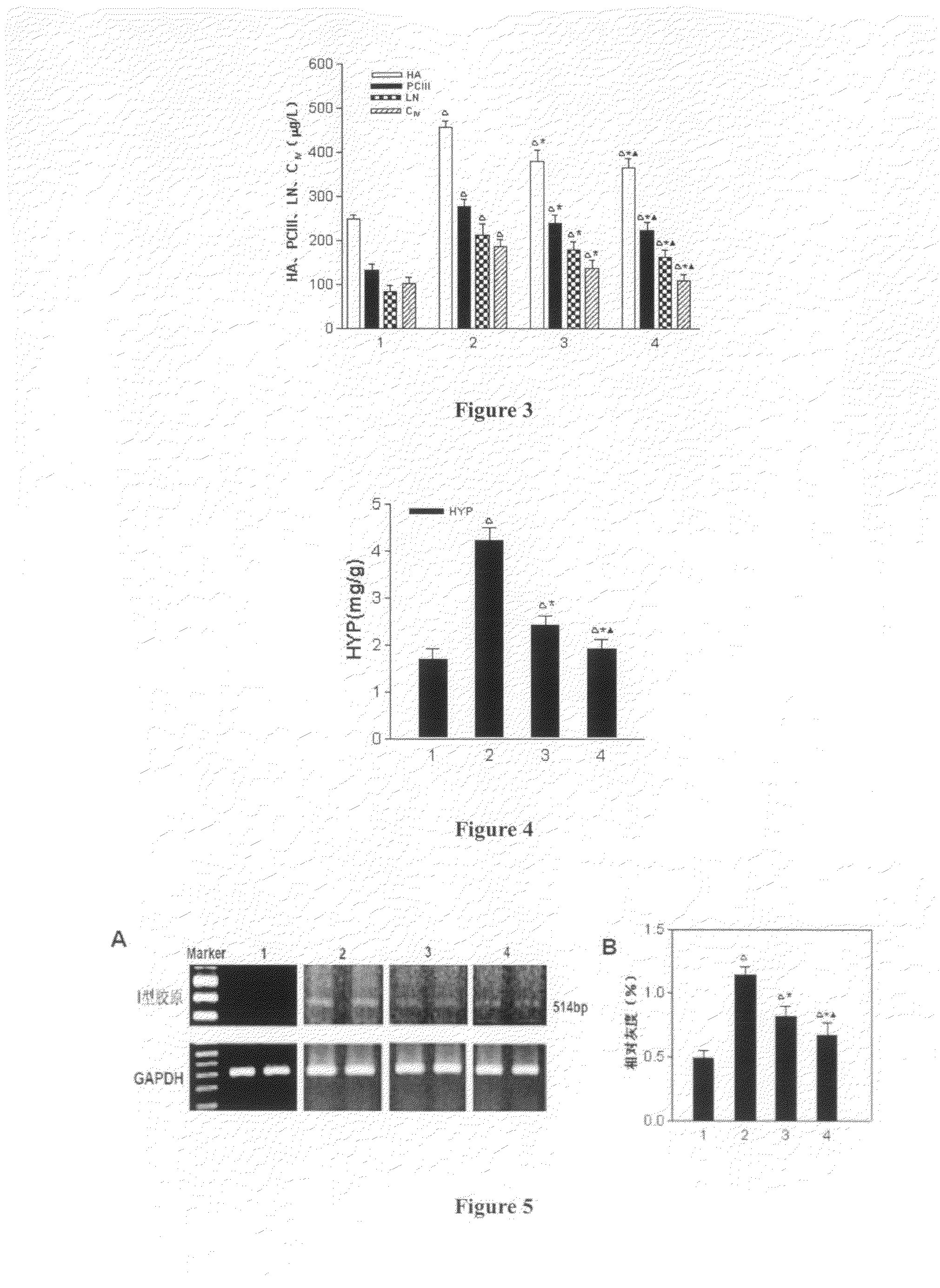Arg-Gly-Asp (RGD) Sequence Containing Cyclic Peptide and Its Active Targeting Liposomes
a cyclic peptide and active targeting technology, applied in the field of pharmaceutical and clinical pharmacy, can solve the problems of hepatic cirrhosis, difficult to design specific therapy targeted to hsc, abnormal sedimentation of extracellular matrix, etc., and achieve good therapeutic effect on hepatic fibrosis, liver function, serous hepatic-fibrotic index, and hydroxyproline content of liver tissue and hepatic pathological changes. significant improvement
- Summary
- Abstract
- Description
- Claims
- Application Information
AI Technical Summary
Benefits of technology
Problems solved by technology
Method used
Image
Examples
example 1
Preparation of RGD Cyclic Peptide
[0030]According to the method reported by literature (Schnolzer M, Alewood P, Jones A, Alewood D, Kent S B. Int J Pept Protein Res. 1992, 40(3-4):180-93), cysteine—Glycine-Argine-Glycine-Asparate-Tryptophan-Proline-Lysine thioester PAM (CysGlyArgGlyAspSerProLys-SCH2CO-leu-PAM) resin was synthesized by protein synthesizer. What was different from literature was that Boc-amino acid (2.2 mmol) was activated in N,N-dimethylformamide (DMF) containing the condensing agent (HBTU 2.0 mmol) and N,N-diisopropyl ethylamine (DIEA 20%, v / v) for 3 min and then added into the resin (0.25 mol) to react for 10 min. N-Boc protecting groups were removed by trifluoroacetic acid (TFA). In the whole process of synthesis, DMF and dichlormethane (DCM) was used to wash the resin. The protecting groups of these used amino acid were Arg(Tosyl), Asp (OcHxl), Cys (4MeBzl), Lys(2ClZ), Ser(Bzl). After the synthesis, the resin was stirred in anhydrous hydrofluoric acid containing 5...
example 2
Preparation of Liposomes
[0031]Rotary evaporation-thin file hydration-extrusion method was used according to following procedures:[0032]1 Egg phospholipid (EPC), cholesterol (Chol), monooxymethyl-polyethylene glycol lipid derivatives and MAL-PEG2000-DOPE were accurately weighed according to the molar ratio 2:1:0.1:0.02, dissolved in chloroform and rotary-evaporated at 40° C. to evaporate the organic solvent to form transparent thin film. Then phosphate buffer (PBS, pH 7.4, 22° C.) was added to fully hydrate the thin film. Homogeneous sterically stabilized liposomes (SSL) were obtained by repeated extrution through 100 nm filter membrane with Mini Extruber for 15 times. The content of PEG was 3.2mol %.[0033]EPC, Chol and MAL-PEG3450-DOPE with the molar ratio being 2:1:0.02 were accurately weighed, dissolved in chloroform and rotary-evaporated at 40° C. to evaporate the organic solvent and form transparent thin film. Then phosphate buffer (PBS, pH 7.4, 22° C.) was added to fully hydrat...
example 3
Investigation of Feasibility of Artificially Synthesized Cyclic Peptide Containing RGD Sequence as the Ligand of Integrin by the Fluorescence and Radioactive Isotope Tracer Method
[0040]According to the feature of ligand-receptor binding, i.e. specificity, concentration and time-dependence, competitive inhibition, fluorescein isothiocyanate (FITC)-labeled RGD cyclic peptide was co-incubated with HSC. Results showed that the binding characteristics of RGD cyclic peptide and HSC followed the basic feature of ligand-receptor binding. Equilibration dissociation constant (W) and the binding site number of each cell (Bmax) was measured by Scatchard analysis of the radioactive ligand of 3H labeled RGD cyclic peptide to be 7.05×10−9 mmol / L and 6.79×105, respectively.
[0041]The procedures were as follows,
[0042]1. HSC were separated from rats.
[0043]2. Investigation of the binding of activated HSC and cyclic peptide by the fluorescence tracer method.
[0044]HSC were inoculated on 6-well plate and...
PUM
| Property | Measurement | Unit |
|---|---|---|
| Particle size | aaaaa | aaaaa |
| Particle size | aaaaa | aaaaa |
| Length | aaaaa | aaaaa |
Abstract
Description
Claims
Application Information
 Login to View More
Login to View More - R&D
- Intellectual Property
- Life Sciences
- Materials
- Tech Scout
- Unparalleled Data Quality
- Higher Quality Content
- 60% Fewer Hallucinations
Browse by: Latest US Patents, China's latest patents, Technical Efficacy Thesaurus, Application Domain, Technology Topic, Popular Technical Reports.
© 2025 PatSnap. All rights reserved.Legal|Privacy policy|Modern Slavery Act Transparency Statement|Sitemap|About US| Contact US: help@patsnap.com



